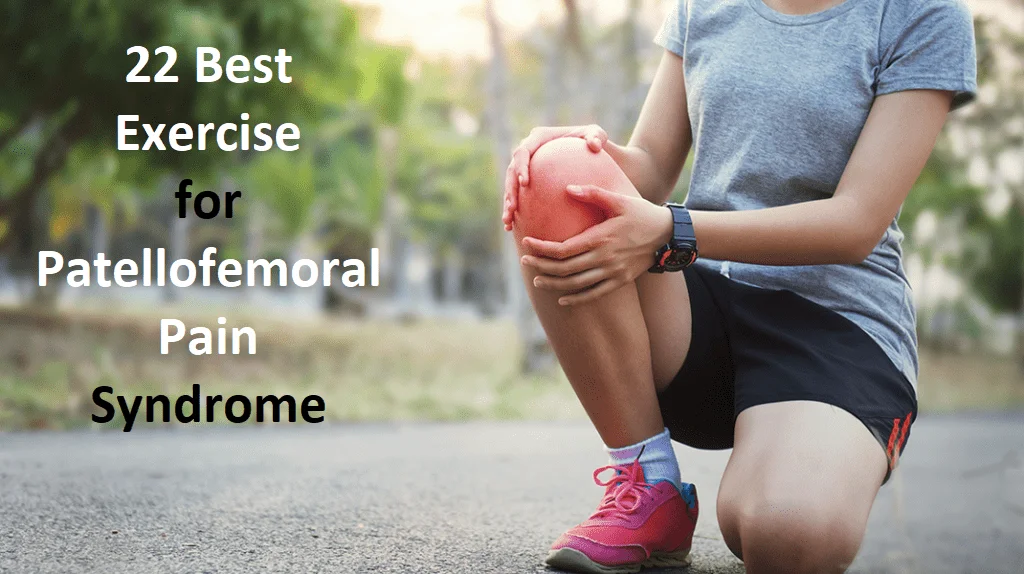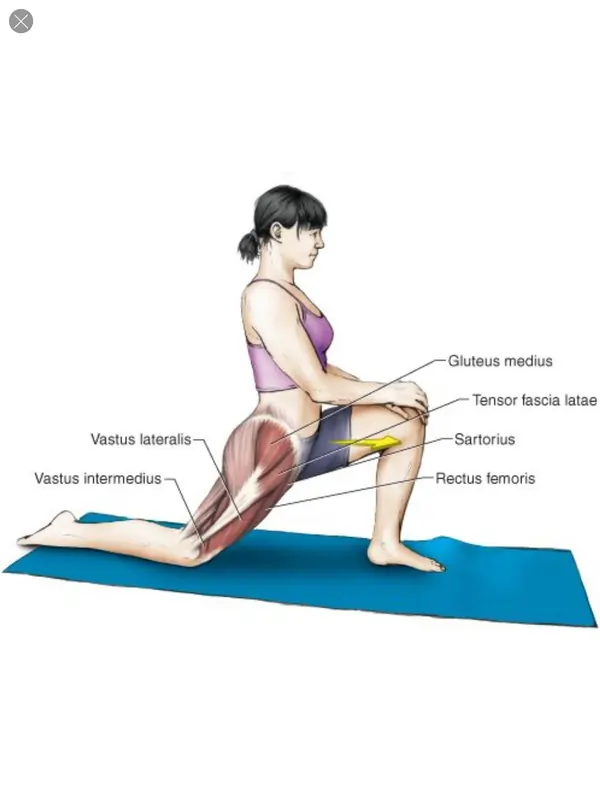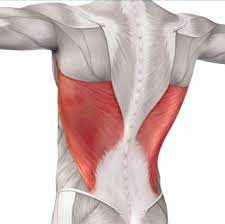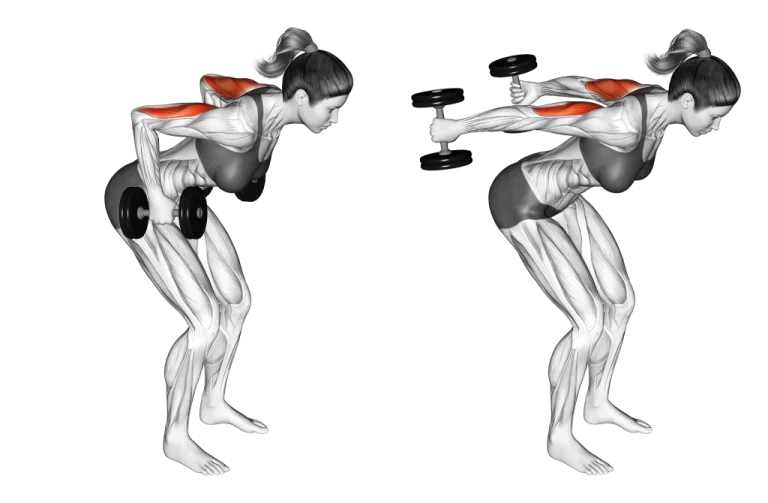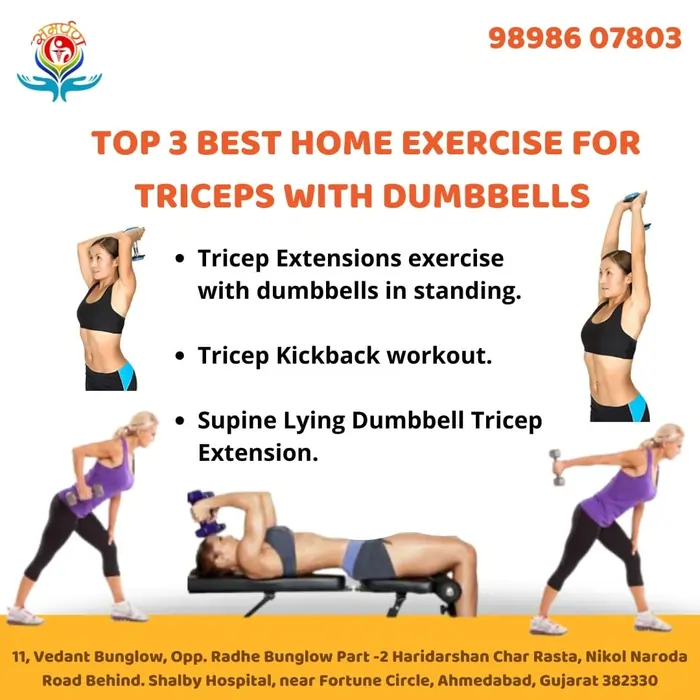22 Best Exercise for Patellofemoral Pain Syndrome
Table of Contents
Introduction
Engaging in appropriate exercises is crucial for managing Patellofemoral Pain Syndrome (PFPS) and promoting speedy recovery. These effective exercises strengthen the Knee muscles while minimizing stress on the patellofemoral joint.
Patellofemoral Pain Syndrome (PFPS) is a common condition characterized by pain around the front of the knee, specifically where the patella (kneecap) meets the femur (thigh bone). It often occurs due to imbalances in muscle strength, improper tracking of the patella, and overuse.
Patellofemoral pain syndrome can be seen in one anterior aspect of the knee or both anterior aspects of the knee. It affects both children and adults. In most cases, there are some aggravated activities of factors that increase knee pain activity such as sitting for a long duration with the knee in flexion. Most people can manage their symptoms with rest, changes in activity level, or physical therapy.
Anyone can develop patellofemoral pain syndrome. PFPS is more likely to occur in women and athletes, including children and young adults. People may experience PFPS most often in sports that involve frequent running, jumping, or squatting. many patients feel pain during daily activities such as stair climbing and sitting for a prolonged duration. sometimes pain increase because of the walking pattern.
Although the exact cause is unclear, it is thought to be due to overuse. Risk factors include trauma, increased physical exertion, and weakness quadriceps It is especially common in runners. Diagnosis is usually based on all-over symptoms and research If pressing the patella into the femur increases the pain, the diagnosis is more likely.
Treatment usually includes rest and rehabilitation with a physiotherapist. Runners may need to stop to condition aggravated activities such as cycling or swimming. Insoles can help some people. Despite treatment, symptoms can persist for years. Patellofemoral pain syndrome is the most common cause of knee pain that occurs in more than 20% of young adults. It occurs approximately 2.5 times more often in women than in men.
Patients should be educated about diagnosis, causes, and treatment. They should be given a list of exercises to do at home or prescribed physical therapy to teach the skater how to do the correct exercises. Patients are advised to rest, take anti-inflammatory drugs, and ice as much as possible during the first 2-3 weeks.
Fast Facts about Patellofemoral Pain Syndrome:
Patellofemoral pain syndrome occurs when these aspects of the knee experience pain such as nerves in the tendons, synovial tissue, and bone surrounding.
The most common symptom of patellofemoral syndrome is a dull, aching pain in the anterior aspect of the knee joint.
Physiotherapy usually diagnoses patellofemoral syndrome based on a physical assessment, special test, and medical history.
Surgery is the last option management of patellofemoral pain syndrome. It is used only in very severe cases and when other non-invasive treatments have failed.
Symptoms of Patellofemoral Pain Syndrome
Patellofemoral pain syndrome becomes the reason for dull, aching pain in the anterior aspect of the knee.
Popping, rubbing, or cracking of the knee after climbing stairs or standing for long periods of time.
Pain during exercise and knee flexion movements aggravates the pain, in activities such as climbing stairs, running, jumping, or squatting also aggravate the pain. Pain in the front of the knee after sitting for a long time with bent knees, such as in the cinema or when.
traveling by plane.
Pain is associated with a change in activity level or intensity, playing surface, or equipment.
Kneecap that is tender to the touch.
Sitting posture for a long duration with knee flexion movement.
Kneeling or squatting during this position pain and aggravates
Causes of Patellofemoral Pain Syndrome
Patellofemoral pain syndrome can have several causes. It’s been linked with:
Excessive use. Running or jumping sports repeatedly stress the knee joint, which can cause irritation under the patella.
Muscle imbalance or weakness. Patellofemoral pain can occur when the muscles in the hip and knee area do not support the knee sometime later Moving the knee inward while squatting has been associated with knee and thigh pain.
Injury. Trauma to the patella, such as a dislocation or tear of the patella, has been associated with patellofemoral pain syndrome.
After Knee surgery three increases the chances of having patellofemoral pain. This is especially true for anterior cruciate ligament repair
using his patellar tendon as a graft.
Kneecap becomes too high in the knee joint
Weak thigh muscles(quadriceps imbalance)
Tight anatomical structures, e.g. retinaculum or iliotibial band
Misalignment of the patella which causes moves become from the femoral groove
Osteoarthritis condition of the knee and bone tumors in or around the knee.
Excessive genu valgum
Tight hamstrings
Tight Achilles tendons
Poor foot support
During Walking or running the feet become rolled in while the thigh muscles pull the kneecap outward
Exercise for Patellofemoral Pain Syndrome
Lying hamstring stretch using a strap

The hamstring stretch exercise starts with the long sitting position. either on the floor or on a mat with your legs fully extended. To stretch your right leg, bend your right leg and place the strap over the ball of your right foot.
Hold the strap with both hands. Keep the left leg extended on the ground with the hip extension. This should give tension(stretch) to your thigh muscles and calf muscles. gradually extend your right hip out with the knee extension. The right hip should be straight, slightly bent at the knee, and the bottom of the calf should be directed toward the ceiling. Pull the strap gently until the hamstrings are slightly stretched. Hold the stretch for 10-30 seconds. Repeat two to four times. The benefit of hamstring stretches can be increased flexibility and improved hip mobility. Both of these benefits help people perform everyday tasks such as climbing stairs and bending over with ease.
Foam roll hamstring stretch

The foam roll hamstring stretch exercise starts with sitting on the mat or floor with your hips should be straight Place the foam roller evenly under the thigh of one leg and bend the other leg so that the foot is flat on the floor.
Lift your glutes off the mat keeping your hands on the floor for balance
Move your body back and forth in long strokes, stopping right at the back of the knee.
Gradually rotate the thigh to make sure the roller goes lateral to the medial aspect of the thigh which covers the origin to the insertion of the muscle.
The benefit of the foam roller hamstring stretch is that it can increase flexibility and improve hip mobility. Both of these benefits help people perform everyday tasks such as climbing stairs and bending over with ease.
Supine leg raise
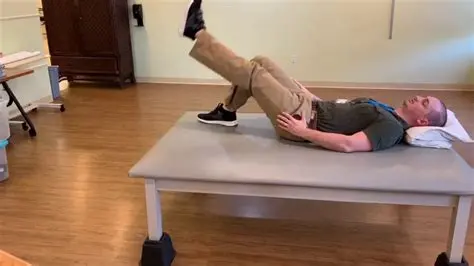
For the supine raise exercise take a supine position on the plinth or mat. do flexion of your knees and hip as well as place your feet hip-width apart on the floor. Start with the pelvic floor and transabdominal muscles. Bring one leg to your chest, then down, keeping your body straight the whole time. During the exercise, you should consider these tips, focus on activating your core muscles and keeping your abs tight, start with your legs slightly bent to protect your lower back, keep your arms at your sides and palms down, and raise your legs until you. reach a 90-degree angle at your hips, and slowly lower your legs back to the starting position. The main benefit of this exercise is to increase core strength, improve hip flexor mobility,
Strengthens lower back muscles, improves posture, and Strengthens abdominal muscles. repetition should be 13-15 per session, three sets per day.
Side leg raises(hip abduction)
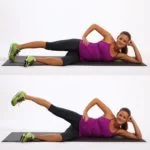
For the side leg raise exercise starts with the side-lying position on your side on an exercise mat with your legs extended. Rest your head on an arm that can be bent or extended. To stabilize the upper body, place the hand of the other hand on the floor in front of the stomach. Raise your upper leg sideways to the ceiling, hold for a moment, then down again. Repeat this exercise 10-20 times. Do the same with the other leg. Make sure you keep your body steady and move slowly and with control. Your upper body should not move when your leg moves. If you want to do a more challenging exercise, you can put an elastic resistance band around your knees.
the straight leg raise exercise increases the mobility of the hip muscles start the exercise in the supine position and move on the side-lying position.
repetition should be 13-15 per session with three sets per day.
Prone leg raise exercise
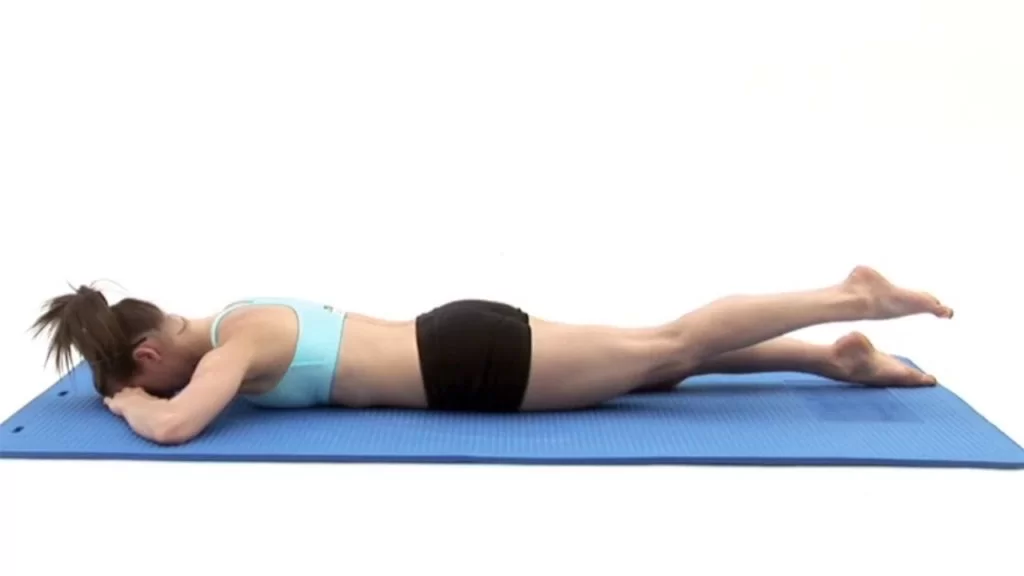
For this exercise, you should lie on your stomach with both legs extended and both hands at your side or down on your forehead for support. Gently tighten the core muscles, holding the abdominal muscles, you should breathe normally. Abdominal muscles should be engaged and knees should be straight. Then slowly raise your right leg to the ceiling. The knees should be straight, the thighs should rise from the ground. Hold the leg straight up in the air for a few seconds and then slowly raise the leg to the floor. Make sure you don’t twist your back or hips when you lift your leg.
Do this exercise for 10-20 repetitions and then repeat this exercise on the other leg. Make sure there is at least a 48-72 hour break between the next workout to allow the muscles to recover.
Your physical therapist has recommended that you do this exercise with alternating legs, especially if you are doing the exercise as part of a lower back rehabilitation program.
If you want to make this exercise more difficult, add more weight to your workout. Roll 2-3 kilograms of weight over the ankle joint and do leg lifts on your stomach.
This increases the resistance when you do this exercise.
You can also wear resistance, such as a Thera band wrap, over your ankle in front of you, this will add resistance and add challenge to the abdominal leg raise.
Static quadriceps exercise
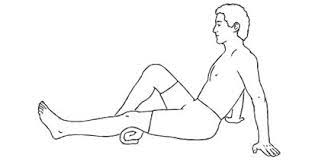
Static quadriceps exercise (SQE) is also known as isometric quadriceps exercise.
Start on the unaffected leg. Sit on the floor or bed. Pull the toes up towards your shin, and push your knee into the napkin or plinth to contract the quadriceps muscles. reason for this press your heel to slightly lift off the floor of the plinth. you can also keep a soft object under your knee such as a softball.
The patellofemoral pain can be aggravated by using muscles to move a joint through the full range of motion.
As people with knee patellofemoral pain syndrome perform quadriceps isometric exercises and improve the strength of the quadriceps. You will experience muscle tensing when hold the position. Hold the muscle tension for around five to ten seconds.
performed the SQE exercise around 15-20 times per session and do three sets per day.
Hip Circles
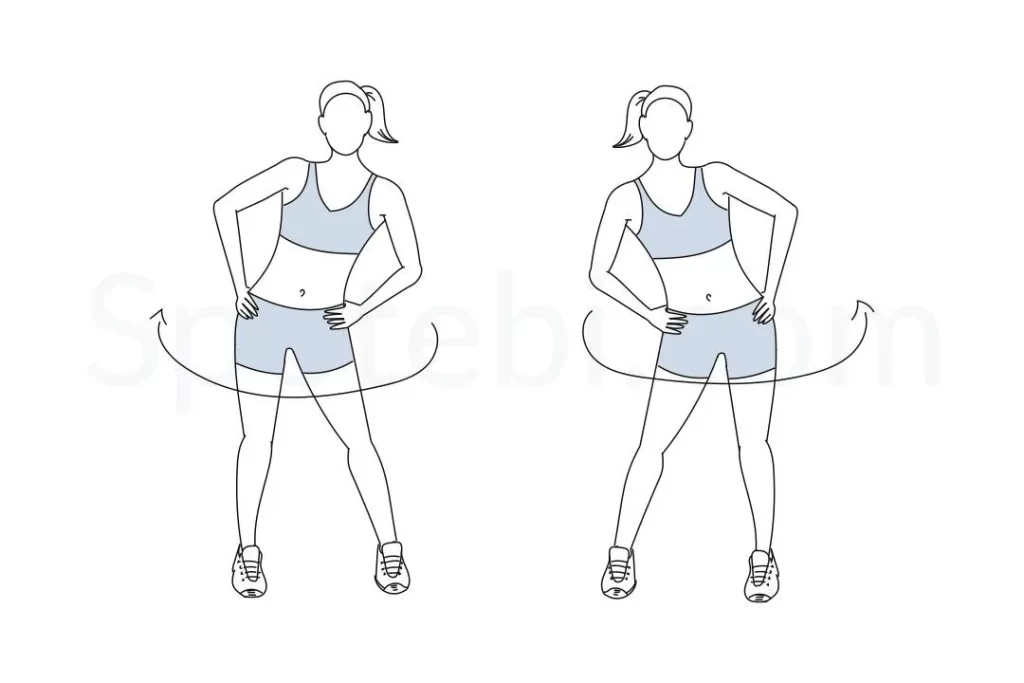
This exercise increases both flexibility and strength of hip and knee muscles. start with the standing position. Stretch the upper body and tighten the muscles. Rotate the leg clockwise 15-20 times. Rotate the leg counterclockwise 15-20 times. Switch to the other side and repeat. Circles should be medium in size, not large and spread out, and not small. Try this exercise for three sets.
Hip circles are a great dynamic stretching exercise. This exercise helps to decrease the tightness of your lower back and hip muscles, strengthens the core, and trims the waist. This is also a great exercise for reducing stress and tension and improving your mobility.
Hip adductor muscle strengthening exercise
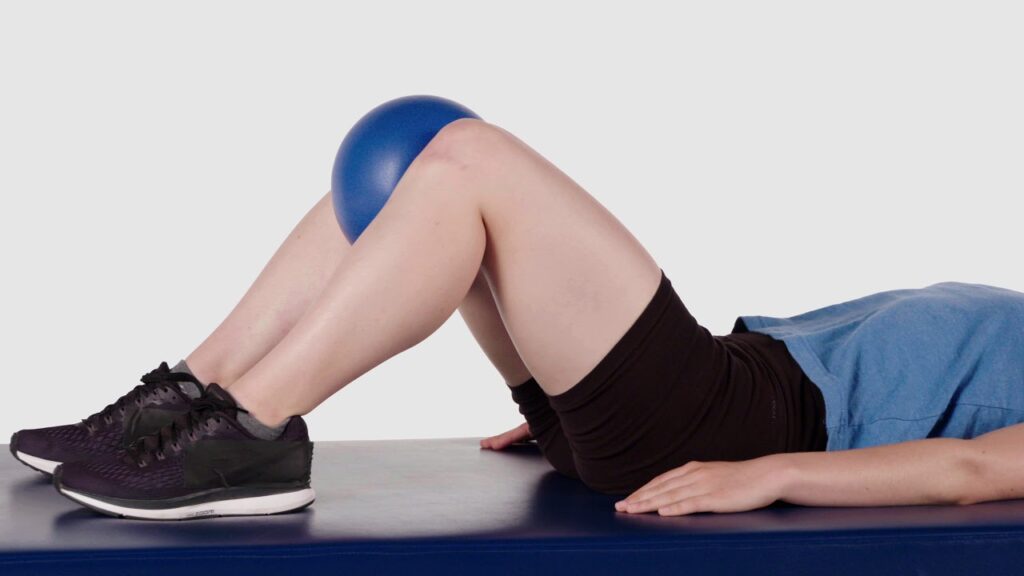
All you need is a pillow or ball for the hip adductor strengthening exercise.
This simple exercise can be done anywhere, even in the living room or on the balcony. It affects the inner thigh muscles, so it helps strengthen the knees and prevent knee pain. The advantage of these exercises is that it strengthens the inner thigh muscles, thus helping to strengthen the knees and prevent knee pain. The strong inner thigh, also known as the adductor muscles, helps secure the hip joints in their sockets.
start with a supine Lying position(on a plinth or mat) with your knee in flexion position and your feet on the floor. Place your feet parallel and in line with your hips. Hands should be placed at the sides of the body, palms down. Relax your neck and shoulders. Place a hard pillow between your knees. If you need support, place a small pillow under your head. This is your starting point. Press your knees together, and press the pillow firmly between your knees. Hold for 10 seconds.
Relax and repeat 10-20 times. Never allow your back to arch or allow tension in your neck, shoulders, or back. Make sure that only your knees are moving without the rest of your body moving.
Prone hamstring curl
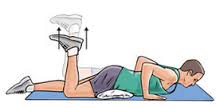
For the prone hamstring curl, start with the prone lying position and adds resistance to your hamstrings. It engages your hamstrings as you flexion of your knees.
Hamstring curl:
Attach the ends of the resistance band to a strong object. take a prone lying position or your stomach with your feet wide apart. Place the band around one heel and bend the ankle. flexion of your knees to pull your heels toward your buttocks, keeping your thighs and hips under the pillow. Stop when you can’t go any further. Return to the starting position. repetition should be 13-15 per session, three sets per day.
Try using heavier resistance bands as you get stronger. Alternatively, you can do hip curls without a resistance band. The main advantage of this exercise is that if you have strong hamstrings, you are less prone to injury and pain. This is because strong hamstrings resist the effects of exercise and help stabilize your knees. Hamstring curls also reduce back pain and decrease the tightness of the hamstring muscles. It’s also best to move slowly. Sudden jerky movements can cause injury, so you need to control your movements. Stop bending your thighs if you feel pain in your knees, hips, or back. A personal trainer can recommend alternative exercises to safely train your legs.
Calf muscle stretch (Towel Stretch)
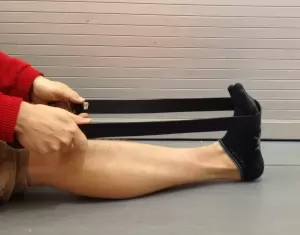
For the calf muscle stretch exercise, you required a towel or a resistance band to stretch your calf muscles. the exercise can be done actively or passively. Begin the exercise sitting on the floor with both legs straight out in front of you. Wrap a resistance band around one foot. Hold both ends of the towel. Keeping your legs straight, pull the towel towards your body and hold the position for 30 seconds. Then relax for 30 seconds. Repeat the stretch three times and then do the same on the other side. Adjust the strength of the stretch by pulling the towel tighter if necessary. The back should be straight during the stretch. The main goal of stretching is to increase the flexibility of the hip flexors, quadriceps, gastrocnemius, hamstrings, and iliotibial band muscles.
repetition should be three times per set and do three sets per day.
Lying Heel slide
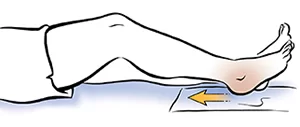
Start with the supine Lying position on your back with your hips straight out in front of you. Use your hip muscles to flexion the knee by pulling it. carry as close to the rear as possible. Keep your feet in contact with the surface you are lying on. Hold for 4-6 seconds and then slide slowly come down and repeat. benefits of these exercises Help improve hip and knee range of motion. Helps to increase the strength of the hip muscles. Helps strengthen knee and ankle ligaments.
Seated Knee Flexion & Extension
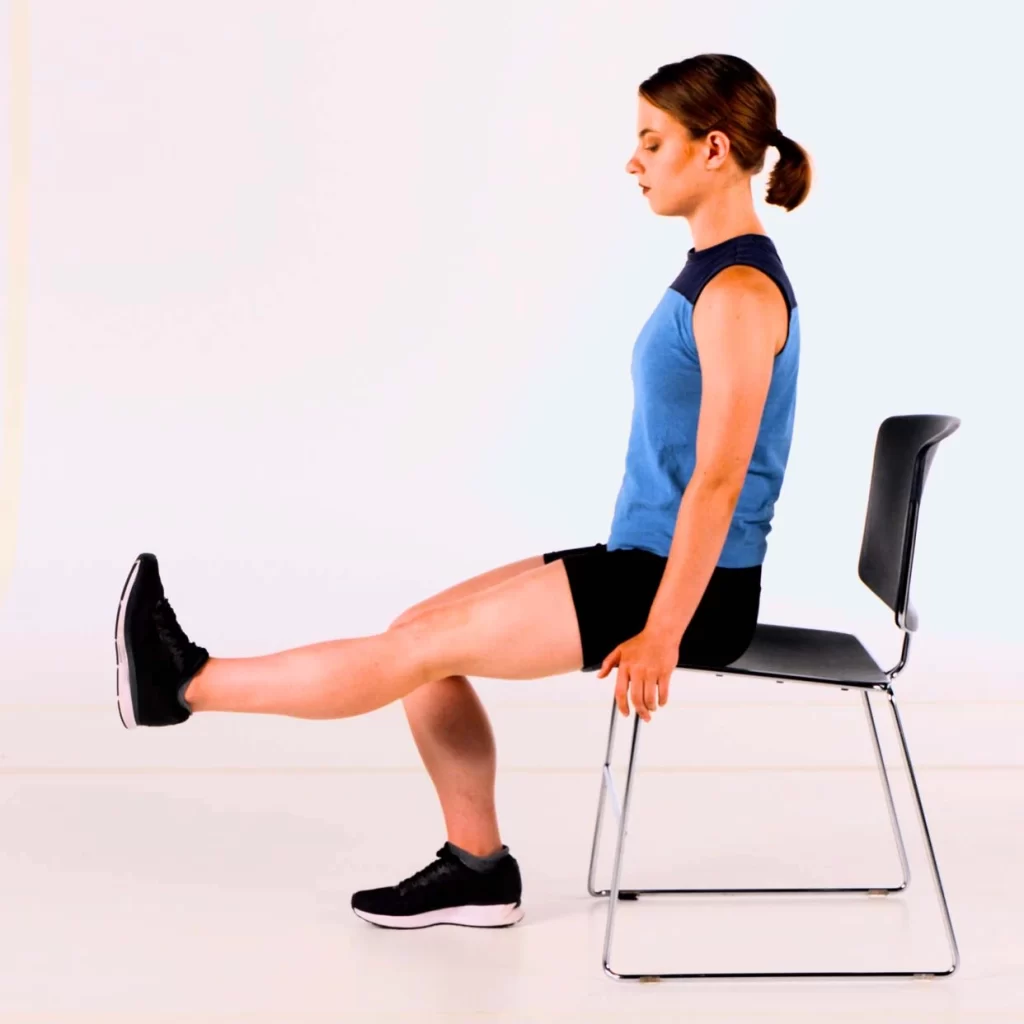
Start the exercise with a Sitting position with a straight back, resting your thighs on the chair. flexion of the affected knee as far back as possible, and hold the flexion position for five to ten seconds. Extend the affected knee as far as possible and hold the extension position for around five to ten seconds, then relax.
This exercise helps strengthen the hamstrings and restore the knee’s range of motion. By the two-week exercise, you should be able to fully extend your knee and bend at least 90 degrees. Do this exercise on both knees.
performed the seated knee flexion and extension exercise around 15-20 times per session and do three sets per day.
Standing hamstring curl
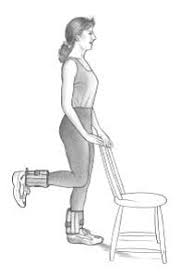
The standing hamstring curl exercise provides strength and mobility to the hamstring muscles. This is an ideal exercise to improve balance and leg strength. How to do a standing thigh curl:
Stand with your feet wide apart. start the exercise by keeping your hands on your waist or on a chair for balance. Shuffle your body weight onto your other leg. Slowly bend your right knee, bringing your heel toward your back. Keep your thighs parallel. Slowly lower your legs.
repetition should be 13-15 per session, three sets per day.
The standing hamstring curl is a great exercise to strengthen the thigh and calf muscles. You can do this exercise in the comfort of your own home. It targets the hamstrings and glutes, two muscles that are often neglected by many exercisers.
The main muscles to target during standing leg curls are the hamstrings, the muscles that start at the hip and extend to the tibia bone. Strong hamstrings are important because they help bend the knees and extend the hips.
Iliotibial band strech
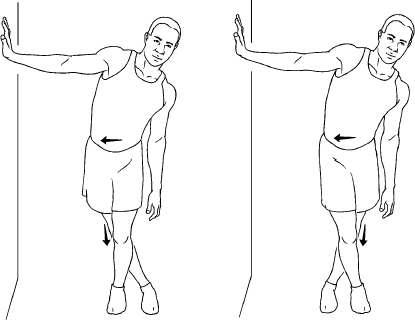
This stretch relieves tightness in the spine, hips, and thighs. This opens up the shoulders and chest, allowing for better posture and stability. this stretch is used to reduce knee pain. For a gentler stretch, stretch your legs. If your thighs are particularly tight, place a pillow under that knee. How to do it:
Bend the left leg on the floor and place the left foot outside the right hip. flexion of your right hip and place your right foot on the floor on the opposite side of your left thigh. Exhale as you rotate your lower body to the right. Place your left fingertips on the floor, and move your hips. Wrap your elbow around your knee or place your elbow on the opposite side of your knee, palm facing forward. Look back over your shoulder. Stay in this position for up to 1 minute and then do the opposite side.
Supine glute stretch
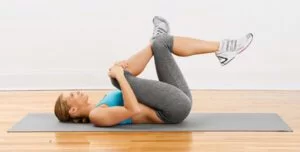
This stretch helps improve hip flexibility by tightening the glutes.
Begin by lying on your back on a yoga mat. Bend your knees and place your feet firmly on the mat, hip-width apart, with your back in a neutral position.
Release and rotate your right leg so that your ankle rests on your left leg, just above the knee. gluteal stretches can help relieve muscle tension and tightness, reduce lower back or hip pain, increase flexibility and range of motion, and reduce your risk of injury. Your glutes work hard to move you.
Pull the left knee toward the body, resting both hands on the back of the left thigh.
Hold the supine glute stretch around the 15-30 position. (or five slow breaths), breathing deeply throughout. Each time you exhale, pull your knee deeper into your chest and push your right elbow into your right knee to increase the stretch as it feels comfortable, keeping your spine neutral and your tailbone on the floor.
do the gluteal stretch three times per session and three sets per day.
Side-lying clamshell exercises
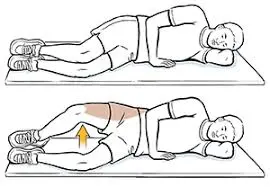
For the clamshell exercise take a side Lying position on your side on the exercise mat, keeping your upper body straight. Rest your head on an arm that can be bent or extended. To stabilize the upper body, place the hand of the other hand on the floor in front of the stomach. Place your upper leg and lower leg on top of each other and bend your legs so that your thighs and calves are at right angles (90 degrees). Now slowly raise the top to the ceiling and lower again, keeping the legs together the whole time. lift your knee along with the pelvic and ankle then hold the position for around five to ten secounds.
repetition should be 13-15 per session with three sets per day. Switch sides. Do a total of 3 sets. If you want to do a more challenging exercise, you can put an elastic resistance band around your knees.
VMO(Vastus medialis obliquus)
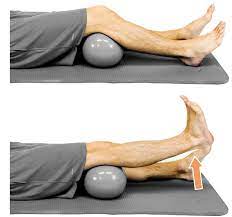
VMO muscle training is appropriate for some, but not all, patients with PFPS. VMO assessment should assess firing, cross-sectional muscle mass, endurance, and ability to fire at various knee angles and is used operationally.
VMO board training is required for the VMO board or bolster. start the exercise lying down and hold the board under the knee, then you will get a bridge position on the knee. then bend the knee and extend the ankle and then hold the position for about 5-10 seconds and then return to the starting position. perform three sets of 15-20 repetitions per session. This can reduce their risk of acute or chronic knee or quadriceps injury, while people undergoing physical rehabilitation for a knee injury can see significant benefits from knee extensions.
Clamshell exercise with a resistance band
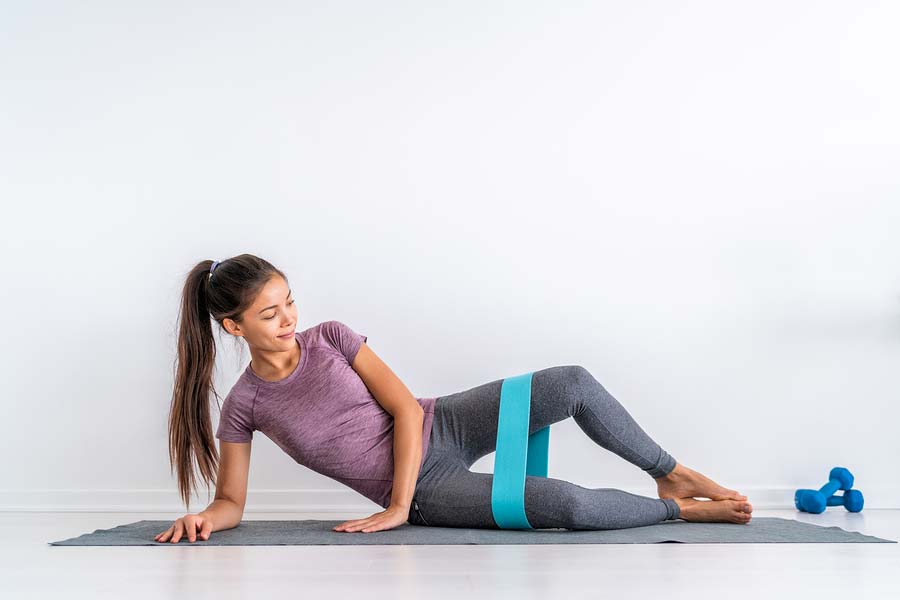
The clamshell exercise with resistance band benefit for the glutes and hamstrings and develops a strong core and back. Make a loop by the resistance band around both thighs, just above the knees. start with the side-lying position on your right side, knees flexion at a 45-degree angle, legs, and hips stacked. Contract your abdominal muscles and take care of your both knee Don’t allow them to lift while exercising. Your hip, knee, and foot should be closed as you raise your left knee toward the ceiling.
Hold the above movement for around two to three seconds and then gradually lower the knee to the starting position. You should engage your core muscles during the exercise, this protects the spine. you should consider must gluteus. you should pivot from the hips, not the lower back. Your neck should be in a neutral position so feel relaxed. Do 20-25 repetitions on each side.
the abnormal or uncomfortable posture It will give tension to your core, hips, and glutes, so you do not get as many muscle strengthening benefits.
Wall sits to strengthen the thigh muscles
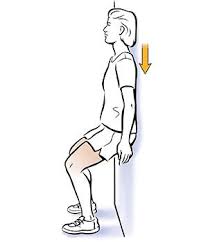
For the wall sits exercise start with the standing position with the posterior aspect of the body to the wall. The feet should be shoulder-width apart and flat against the floor in front of you. Now fold your arms in front of you and slowly slide your upper body down the wall until your thighs and calves are at a 90-degree angle. You have reached the correct position when your thighs are horizontal, your knees are pointed forward and your back is pressed against the wall.
Stay in this position initially for about 20-30 seconds. After a while, you can gradually increase it to a minute, adding 5-10 seconds each time. Repeat the exercise 3 times. After each wall session, slide your upper body against the wall with your legs extended and rest for 30 seconds. the main benefit of these exercises it improves the muscle strength of the hip and knee. and also improve the flexibility of the hip and knee muscles.
repetition should be five to ten per session with three sets per day.
Squats
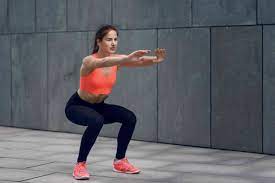
Stand straight with your feet shoulder-width apart and your toes pointed slightly outward. While still standing, gradually bend your knees and straighten them again. When you bend your knees, your hips move back (as if you were sitting in a chair). The center of gravity of your body should remain above your knee joints. Your neck and head should be in line with your back, which you keep straight (don’t let it arch forward).
You can extend your arms in front of you to maintain balance. Start first with quarter squats – that is, bend your legs to about 45 degrees. After a while, you can increase the intensity with weights. Do a total of 3 sets of 10-20 reps with 30-60 seconds rest.
you can start with the mini squat and then shift to the full squat. The benefits of squats include increse the muscle strengthening of hip and knee muscles, injury prevention, and reducing pain. Squats exercise does not need any specific object and can be performed commonly anywhere.
Step-ups
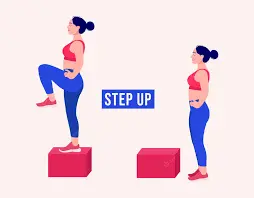
For step-up exercise, you will require a stable small stool or an aerobic step. start with standing about 10 cm in front of a step or bench. Place your right foot on it and then step on it, extending your right leg. Raise your left leg until your thigh is horizontal (parallel to the ground). Place your one foot back on the ground.
To maintain balance, move your arms in the opposite direction to your legs. Repeat 10-20 times and then switch sides. Do a total of 3 sets. Since squats stress the knees, they should not be done if they hurt too much. The higher the step or bench, the harder it is to get up. If you can’t keep your feet still, use a lower step or bench. This exercise strengthens the muscles of the front of the thigh and the muscles of the bottom (buttocks). this exercise increases the mobility of hip and knee joints.
Knee stabilization
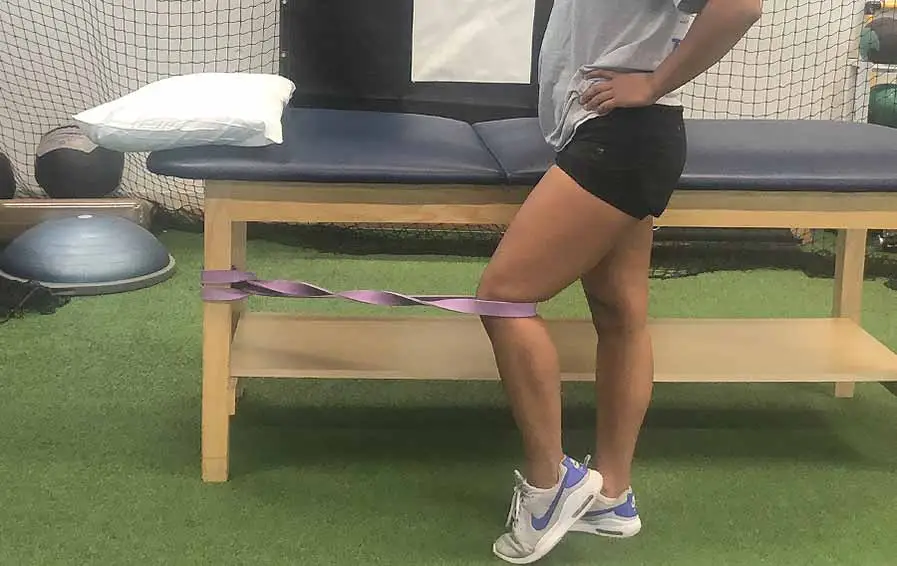
Knee stabilization exercise is the strengthening exercise. Wrap a piece of flexible tubing around the ankle of the uninjured leg. Tie a knot at the other end of the hose and close it to the door. Stand facing the door with the leg without the tube and bend the knee slightly, keeping the hamstrings tight. Hold this position and move the leg so that the hose is directly behind the back. performed three sets of ten repetitions. Turn 90 degrees so the leg without the hose is closest to the door. Move the leg with the tube away from the body. performed the three sets of ten repetitions.
Turn 90 degrees your knee again so your knee joint is against the door. Move your leg so that the tubes are directly in front of you. performed three sets of ten repetitions.
Turn your body 90 degrees again so that the leg with the hose is closest to the door. Move the leg with the tubes across the body. performed three sets with ten repetitions. If you need help balancing, hold onto the side of the chair. This exercise can be made even more difficult by standing on a pillow while moving your leg with the tube.
Precautions while exercising
It is important to do exercises correctly and safely. proper follow all steps of the exercise(performed the step by step exercise)
Avoid sudden or jerky movements during exercise
make sure you maintain good posture – keep your heart steady and your legs straight: don’t bend your knees in or out.
wear comfortable sports clothes in which you can move freely, and strong padded sports shoes with non-slip soles.
It is also important to make sure that the exercises are not too painful. When doing exercises, you can use a scale of 1-10 (1 = no pain, 10 = very severe pain): If there is pain, it should not be worse than 3 on a scale of 10. If it is worse, you can, for example, do fewer repetitions or reduce the intensity of the exercises. If you have any questions, it is best to consult a physical therapist or doctor. It’s also a good idea to get professional help if you have other illnesses or health problems. Together, you will find the right training program for you.
If the knee joint is inflamed, swollen, and painful even at rest, you should not do strengthening exercises.
Risk factors of patellofemoral pain syndrome
Factors that can increase your risk include:
Age. Patellofemoral pain syndrome usually affects teenagers and young adults. Arthritis is more responsible for knee problems(pain etc.)
older people. gender Women are twice as likely to have patellofemoral pain than men. This may be because women’s pelvis is broad compared to the male pelvis. A wider pelvis increases the angle where the bones of the knee joint meet.
Some sports. Running and jumping can give strain the knee muscles. This especially occurs during the training or practice time of the game.
Key points about runner’s knee
Runner’s knee is dull pain anterior aspect of the knee.
This could be caused by a structural defect or a specific walking or running pattern
Symptoms include pain and rubbing, grinding, or popping of the patella.
Treatment includes not running or aggravating physical activity until the pain is decreasing. Using cryotherapy(cold packs), compression and elevation can also help. Medicine like ibuprofen, can reduce pain and reduce inflammation. mobility, Stretching, and strengthening exercises can help prevent the runner’s knee. take advice from your physiotherapist about the condition do some home remedies, and avoid aggravated activity.
Treatments of Patellofemoral Pain Syndrome at Home
Your treatment will depend on the severity of your patellofemoral pain condition. Surgery is usually not recommended for PFPS. Resting the knee at home using the RICE procedures can relieve symptoms. RICE represents the rest, ice, compression, and elevation.
Rest: Avoid pressure on the knee.
Cryotherapy: Avoid direct contact with the ice from your knee joint. Instead, use cold packs wrapped in a towel for no more than 20 minutes at a time, several times a day.
Compression Therapy: Wrap the knee lightly with an elastic bandage, leaving an opening above the patella. Confirm the connection is not too densely packed. Make sure the bandage doesn’t cause more pain.
Elevation therapy: Keep your knees above your heart. Talk to your doctor before using over-the-counter pain relievers such as nonsteroidal anti-inflammatory drugs (NSAIDs) such as ibuprofen.
For home remedies, your management may include:
Physical therapy: Specific exercises will help you regain strength, endurance, and range of motion in your knee. physiotherapy focused on the flexibility of tightened muscles such hamstring. And then focused on the mobility of flexion and extension of the knee joint. by using some equipment to provide strength to the weakened muscles around the knee.
Orthosis devices: orthosis is a mechanical device that gives proper alignment to the body and special parts for this condition may stabilize and give proper alignment to the foot and ankle. Better alignment removes strain from the calf and knee.
Other: For severe PFPS, doctors will do an MRI to evaluate other structural problems. If they are detected, surgery can be performed choice The procedure can remove damaged bone or cartilage or move tendons to correct patellar misalignments.
Prevention for patellofemoral pain syndrome
Patellofemoral syndrome can be painful and debilitating. Although not all cases can be prevented, certain measures can be taken to reduce the risk of knee problems. They include:
Maintaining muscle balance: Strengthening knee and leg muscles can reduce the risk of muscle imbalances and promote proper knee alignment.
Correcting flat feet: Using sturdy shoes and shoe parts can treat flat feet and reduce extra stress on the knee joints.
A healthy weight: Carrying too much weight puts stress on the joints and increases the risk of patellofemoral syndrome. for maintaining a healthy weight you can follow a properly balanced diet.
Warming up before exercise: a person should always stretch and do a light activity before a proper workout. This can increase flexibility and reduce injury.
Gradual changes to exercise programs: Sudden increases in exercise intensity, duration, or frequency can contribute to knee pain.
Avoid knee strains: Choosing low-impact activities, wearing supportive shoes, and using knee braces during exercise can help reduce the impact on the knees and feet.
Knee Orthosis
There are some clinical predictors that help determine whether or not a patient is more likely to benefit from orthotics;
People with PFPS who wear less supportive shoes,
those who report less pain,
show less ankle dorsiflexion range of motion,
A patient reports an immediate reduction in pain when squatting with one leg with the use of foot orthoses.
The study used foldable orthoses; made of medium-density ethylene vinyl acetate, including built-in arch supports and 4-share gussets. The foldable foot orthoses significantly improved the functional performance of PFPS patients at 12 weeks, and these improvements were greater than those observed immediately after using the foot orthoses. These improvements may be important for long-term prognosis and prevent the development of osteoarthritis in some people with patellofemoral pain syndrome.
Top 3 Patellofemoral Exercises to Avoid
While these conditions you can stop these exercises in a gym session. you Remember: exercise should never cause pain, maybe discomfort, but not pain. If you experience sudden, sharp, or sudden pain in your knee, stop and contact your doctor or physical therapist.
These three exercises you should avoid in the gym while workout:
Deep squats
Leg Extension Machine
Lunges
A note from Samarpan Physiotherapy Clinic
During patellofemoral pain syndrome, you can feel the pain anterior aspect of the knee. take care of your condition wear knee orthosis which is made up of cushion material that provides stability to the knee. for pain relief, you can involve the RICE method with medications. for the mobility and strength of muscles, you can come to our Samarpan Physio. clinic. our treatment protocol adds mechanical and manual therapy.
Mechanical therapy involves the modality which provides pain relief and manual therapy involve all stretching, mobility, and strengthening exercise. the exercise maintains the range of knee and hip joints and stretching exercises provide flexibility to the knee and hip muscles. during this condition, your main focus is on the quadriceps muscle. start with the knee isometric exercise then the strengthening exercise. Gait or locomotion retraining during this condition is recommended by our clinic.
FAQ
Patellofemoral Pain Syndrome – samrpanclinic
Patellofemoral pain syndrome (PFPS) is an effect on the anterior aspect of the knee joint that’s why this condition avoids some specific activities which aggravated the pain. It is a chronic disease that is aggravated by, for example, squatting, sitting, climbing stairs, and running.
What is the fastest way to treat patellofemoral pain syndrome?
The great way to treat patellofemoral pain syndrome is to provide rest to your knee and avoid aggravating activities that become the reason for pain. Ice and anti-inflammatory medications such as ibuprofen can be used to treat swelling or pain. Targeted physical therapy and strengthening exercises also promote recovery.
Exercises for patellofemoral knee pain. After any patellofemoral knee pain, it is important to regain movement and strength. It supports tissue healing and gets you moving again. You may not be able to return to your normal level of exercise right away, and recovery may be gradual.
Patellofemoral Pain Syndrome – samrapnclinic
It may take six weeks or more to notice improvement. If symptoms do not improve after six weeks of conservative treatment, surgery may be necessary.
Patellofemoral pain syndrome (PFPS) is one of the most common problems throughout these conditions the age range is between 15 -30 age group.
Important note: Healthcare professionals should reassure patients that patellofemoral pain does not always resolve on its own, especially in those with long-standing symptoms (>12 months) and poorer symptoms and function.
Patellofemoral Pain Syndrome (Runner’s Knee)Rehabilitation Exercises
Straight leg raise: …
Step-up: …
Wall squat with a ball: …
Knee stabilization: …
Resisted terminal knee extension: …
Standing calf stretch: …
Clam exercise: …
Iliotibial band stretch: Side-bending:
Patellar Fractures
A patella fracture is a serious injury that can create difficulty in daily activities such as walking(locomotion) and even impossible to straighten the knee. simple patella-type of fractures can be treated with an orthosis or plaster-cast until the bone heals. in another type, of patella fracture, the bone fragments are displaced when the accident occurs.

